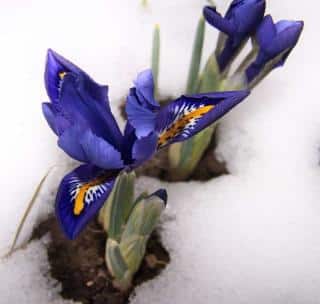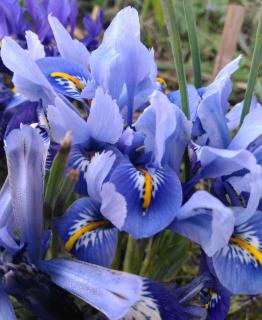

Iris reticulata is one of the first (blueish) flowers of spring, appearing in sync with snowdrop and early crocus.
Technical Iris reticulata facts:
Name – Iris reticulata
Family – Iridaceae
Type – perennial bulb plant
Height – 1 ½ feet (15 cm)
Exposure – well-lit
Soil – cool, draining well
Foliage: deciduous
Flowering: winter’s end, beginning of spring
Commonly called reticulated iris, this dwarf plant has small blooms that are 1 to 2 inches tall (3-5 cm), and foliage that is similar to that of daffodil. The blue color of its flowers is impossible to miss at the end of winter or around the beginning of spring, depending on your geographical area.
Iris reticulata grows in the wild in the cold, dry mountains of Turkey, Irak, Iran and Russia. Saying it’s not afraid of the cold is not an understatement! Extremely hardy, this iris can grow nearly everywhere.
Bulbs need a constant renewal of moisture in spring, but must stay rather dry during summer and fall. They’ll simply start rotting in heavy, wet soil.
Rock gardens and landscaping with gravel are ideal locations for these bulbs. Also consider planting a few in the water drainage hole near decks or downspouts. Another option is to grow these bulbs in a pot.
 Plant the bulbs in soil that drains well.
Plant the bulbs in soil that drains well.Landscaping tip: plant daffodils at the beginning of spring to play around with the stark contrast between the intense blue of dwarf iris and the bright yellow daffodils display. Grape hyacinths, which also bloom in the same week, are great companion plants.
Once the flower has finished blooming, its leaves will quickly wilt away and the bulbs drop into dormancy until the middle of the following winter. Nothing to do at this stage.

Info: the planting period for bare bulbs may range from beginning of October in the north, to mid-November in the south.
A good rule is to plant them about 6 weeks before the ground freezes up.
Even though Iris reticulata propagate on their own as years come and go, it still takes a few years for new bulbs to mature and start blooming. The best way to guarantee an abundance of flowers every spring is to plant fresh new bulbs every year. Nonetheless, dwarf iris that are happy where they were sown will bloom repeatedly year after year.
To “reduce” the number of bulbs if they’re overcrowded, dig them out at the end of summer and segregate them. Plant about half of them in the same area, and find new places to plant the ones left over.
As a family, iris tends to not suffer much from disease. Most problems are due to excess moisture, especially during the summer.
Flowers from a specific cultivar, Iris reticulata ‘Harmony’ are quite remarkable: their bright cobalt blue color and bright yellow dashes of color decorate the drooping petals. The yellow spot is a botanical curiosity, called “reticulation”: this is where the species’ name comes from. (reticulata).
Read also: